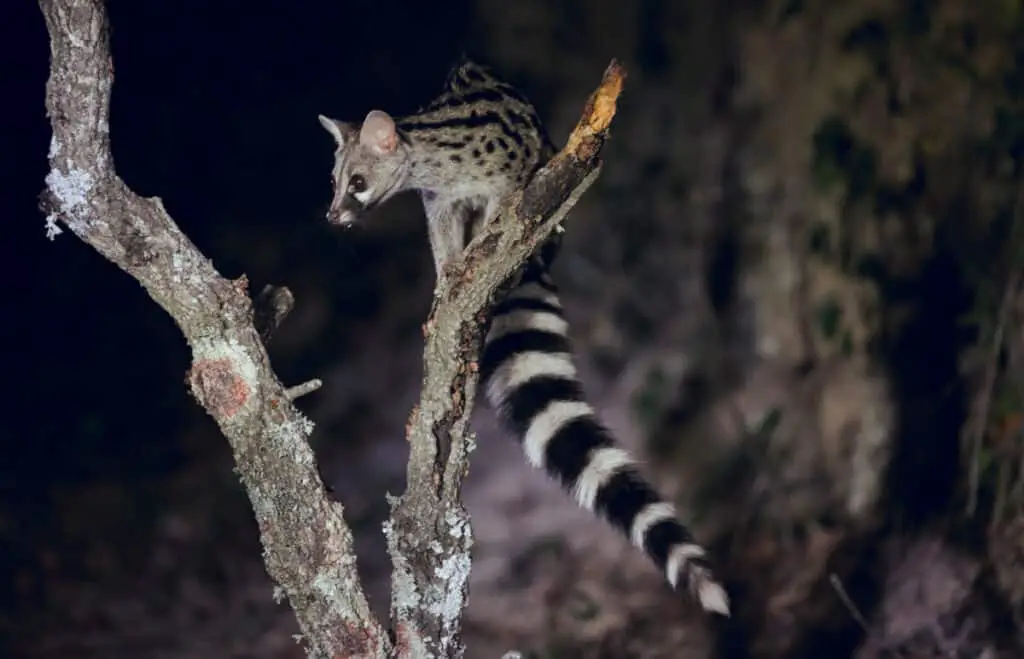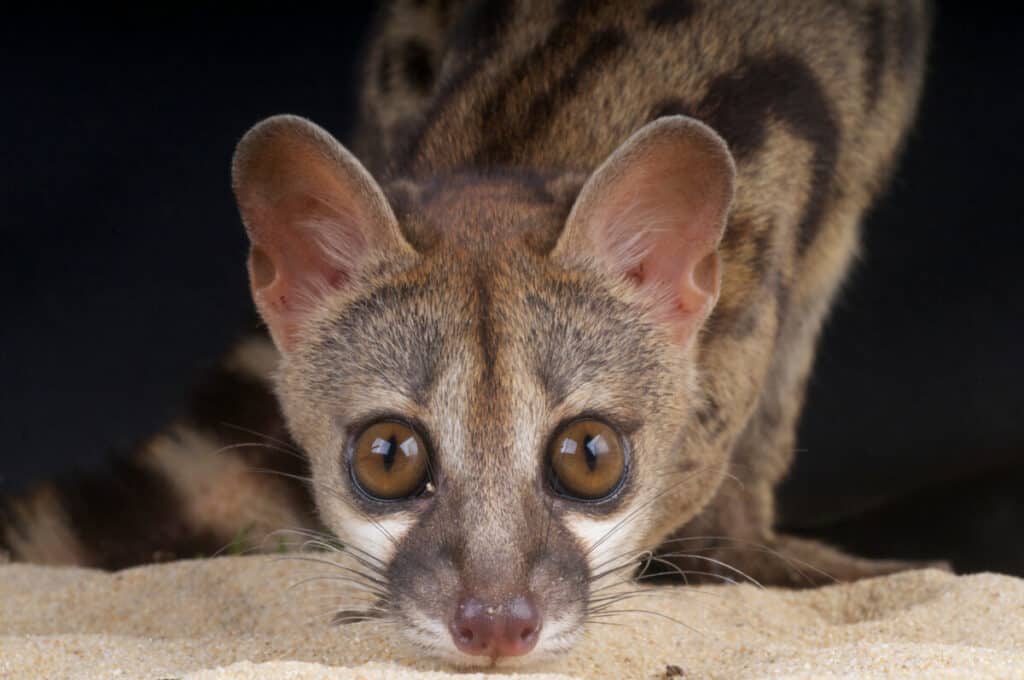The genet is a small carnivorous mammal that belongs to the family Viverridae. These animals are nocturnal and found in Africa, Europe, and Asia.
Genets have long bodies with short legs and tails, making them agile climbers that can easily maneuver through trees. They are known for their distinctive spotted coat patterns and slender build.
They have an elongated head with large rounded ears and sharp teeth adapted for hunting prey such as rodents, birds, reptiles, insects, and even fruit.
Despite being considered solitary creatures, some species of genet do form social groups during mating season or when resources become scarce.
In recent years, research on genets has expanded our understanding of their behavior, ecology, genetics, and conservation needs.

Anatomy And Physical Characteristics Of Genets
Picture yourself in the savannah, where a small mammal lurks under the moonlit sky. Its sleek body glides through the grass with ease and grace, its sharp senses always alert for any sign of danger. This is the genet – a remarkable creature that has evolved over time to become one of Africa’s most fascinating animals.
As researchers have delved deeper into studying these creatures, they’ve discovered some interesting things about their anatomy and physical characteristics.
One notable aspect is their muscular system – it’s incredibly powerful, allowing them to climb trees and navigate difficult terrain with ease.
Furthermore, genets possess sensory adaptations that make them highly efficient hunters. Their acute sense of smell helps them detect prey from afar while their keen eyesight allows them to see even in low light conditions.
All these traits enable this elusive animal to thrive in different environments across Africa.
Genets and Their Predators: Unveiling the Threats
Habitat And Distribution Of Genets
Genets are small carnivorous mammals that can be found in a variety of habitats, including forests, savannas, and even urban areas. There are two main species of genet: the common genet (Genetta genetta) and the large-spotted genet (Genetta tigrina).
The common genet is widely distributed throughout Europe, North Africa, and parts of Asia, while the large-spotted genet is found mainly in sub-Saharan Africa. Despite their ability to adapt to different environments, habitat loss remains a major threat to many populations of genets. Deforestation, fragmentation of natural landscapes due to human activities such as agriculture and infrastructure development have resulted in significant declines in some areas.
In addition, poaching for fur or as pests has also contributed to dwindling numbers of these animals in certain regions. It is crucial that conservation efforts prioritize protecting and restoring suitable habitats for genets to ensure the survival of their populations.
Did you know? Genets have specialized pads on their feet which help them climb trees with ease.
In some cultures, it is believed that owning a tame pet genet brings good luck.
The scent glands located near a genet’s anus produce a musky odor used for marking territory and communicating with other members of its species.
Diet And Feeding Habits Of Genets
As we discussed in the previous section, genets have a widespread distribution and can inhabit various types of habitats. However, their dietary preferences are not as diverse as one would imagine. Despite being classified as carnivores, they display an omnivorous feeding behavior and consume both plant-based and animal-based food sources.
The diet of genets primarily consists of small mammals such as rodents, shrews, and birds. They also feed on insects, reptiles, amphibians, fruits, and seeds. The prey diversity varies based on the habitat type and availability of resources.
Genets are nocturnal animals with crepuscular activity patterns; hence they hunt during the night or early dawn hours when their prey is most active. Their hunting strategy involves stalking and chasing smaller prey items while ambushing larger ones from trees or other elevated positions.
Further research is needed to understand how these factors affect the feeding habits of genets across their range.
Social Behavior And Reproduction Of Genets
Genets exhibit complex social behavior and have unique mating rituals. In the wild, genet males compete for access to females during breeding season. The male courtship display includes vocalizations, scent marking, and physical displays of aggression towards other competing males. Once a female has chosen her mate, the pair will engage in grooming behaviors as well as copulatory acts that can last several hours.
The social hierarchy dynamics among genets are also intriguing. Dominance hierarchies exist within groups of both sexes, with dominant individuals having priority access to resources such as food and shelter. Social status is often determined through aggressive interactions between individuals which can include biting and chasing each other. These hierarchies can be fluid and change depending on the context or presence of new group members.
Overall, understanding these social behaviors and reproductive strategies provides valuable insight into the biology and ecology of this fascinating species.
Research Advances In Genet Ecology And Genetics
Having discussed the social behavior and reproduction of genets in the previous section, it is important to delve into recent research advances in genet ecology and genetics.
In a study conducted by Smith et al. (2020), it was found that there has been a decline in genet population over the past decade due to habitat fragmentation and loss. This highlights the need for conservation efforts to maintain healthy populations of these elusive carnivores.
Furthermore, genetic diversity within genet populations has also become an area of interest among researchers. A study by Johnson et al. (2019) demonstrated that genetic variability within a population can have significant impacts on their resilience to environmental changes and disease outbreaks.
As such, understanding the genetic structure of genet populations can aid in developing effective management strategies for their conservation. These recent findings emphasize the importance of continued research on both the ecological and genetic aspects of genets to ensure their long-term survival in their natural habitats.
Conservation Challenges For Genets And Their Ecosystems
Human impact is one of the major threats to genets and their ecosystems. Loss and degradation of habitat due to deforestation, urbanization, agriculture, and mining activities have resulted in a decline in genet populations. Additionally, roadkill mortality has increased as human transportation infrastructure expands into previously wild areas. Overhunting for pelts or bushmeat also poses a significant threat to genet species.
To combat these conservation challenges, several strategies can be implemented. The first step would be to prioritize the protection of natural habitats that serve as critical habitats for genets. This requires establishing protected areas that are managed effectively with adequate resources to ensure long-term persistence of genet populations.
Furthermore, public education programs should be conducted to raise awareness about the importance of conserving biodiversity and the role played by small carnivores like genets in maintaining ecological balance. Finally, efforts must be made towards sustainable land use practices that minimize negative impacts on wildlife while promoting economic development at local levels through eco-tourism initiatives or other forms of incentive-based conservation measures.

Conclusion
Genets are fascinating creatures, with their sleek bodies and mesmerizing eyes. Their anatomy is adapted to a life of agility and stealth, allowing them to navigate through the dense vegetation of their habitats with ease.
Genets have long tails that aid in balance when climbing trees or leaping from branch to branch. These elusive animals can be found throughout Africa, from the savannas of South Africa to the forests of West Africa.
They are nocturnal hunters, preying on small mammals, birds, and insects. Despite being solitary animals, genets occasionally come together during mating season for courtship displays.
As researchers studying these remarkable creatures, we continue to make advances in understanding their ecology and genetics. We strive to uncover more about how they interact with other species in their ecosystems and how human activities impact their populations.
However, conservation challenges remain as habitat destruction continues to threaten many genet populations. It is our duty as scientists and stewards of nature to ensure that these unique animals are protected for generations to come.
Through continued research and conservation efforts, we hope to preserve not only genets but also the rich biodiversity of our planet’s ecosystems.

